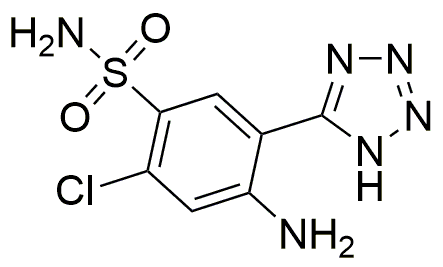5-(2-Amino-4-chloro-5-sulfamoylphenyl)-1H-tetrazole is widely utilized in research focused on:
- Pharmaceutical Development: This compound is explored for its potential as an antibacterial agent, particularly in the development of new medications targeting resistant bacterial strains.
- Agricultural Chemistry: It is used in formulating agrochemicals, helping to create effective herbicides and pesticides that enhance crop yield while minimizing environmental impact.
- Analytical Chemistry: The compound serves as a reagent in various analytical techniques, aiding in the detection and quantification of specific substances in complex mixtures.
- Biochemical Research: Researchers utilize it to study enzyme inhibition and receptor interactions, providing insights into metabolic pathways and disease mechanisms.
- Material Science: It is incorporated into the development of specialty materials, such as coatings and polymers, which require specific chemical properties for enhanced performance.
General Information
Properties
Safety and Regulations
Applications
5-(2-Amino-4-chloro-5-sulfamoylphenyl)-1H-tetrazole is widely utilized in research focused on:
- Pharmaceutical Development: This compound is explored for its potential as an antibacterial agent, particularly in the development of new medications targeting resistant bacterial strains.
- Agricultural Chemistry: It is used in formulating agrochemicals, helping to create effective herbicides and pesticides that enhance crop yield while minimizing environmental impact.
- Analytical Chemistry: The compound serves as a reagent in various analytical techniques, aiding in the detection and quantification of specific substances in complex mixtures.
- Biochemical Research: Researchers utilize it to study enzyme inhibition and receptor interactions, providing insights into metabolic pathways and disease mechanisms.
- Material Science: It is incorporated into the development of specialty materials, such as coatings and polymers, which require specific chemical properties for enhanced performance.
Documents
Safety Data Sheets (SDS)
The SDS provides comprehensive safety information on handling, storage, and disposal of the product.
Product Specification (PS)
The PS provides a comprehensive breakdown of the product’s properties, including chemical composition, physical state, purity, and storage requirements. It also details acceptable quality ranges and the product's intended applications.
Certificates of Analysis (COA)
Search for Certificates of Analysis (COA) by entering the products Lot Number. Lot and Batch Numbers can be found on a product’s label following the words ‘Lot’ or ‘Batch’.
Numéro de catalogue
Numéro de lot/série
Certificates Of Origin (COO)
This COO confirms the country where the product was manufactured, and also details the materials and components used in it and whether it is derived from natural, synthetic, or other specific sources. This certificate may be required for customs, trade, and regulatory compliance.
Numéro de catalogue
Numéro de lot/série
Safety Data Sheets (SDS)
The SDS provides comprehensive safety information on handling, storage, and disposal of the product.
DownloadProduct Specification (PS)
The PS provides a comprehensive breakdown of the product’s properties, including chemical composition, physical state, purity, and storage requirements. It also details acceptable quality ranges and the product's intended applications.
DownloadCertificates of Analysis (COA)
Search for Certificates of Analysis (COA) by entering the products Lot Number. Lot and Batch Numbers can be found on a product’s label following the words ‘Lot’ or ‘Batch’.
Numéro de catalogue
Numéro de lot/série
Certificates Of Origin (COO)
This COO confirms the country where the product was manufactured, and also details the materials and components used in it and whether it is derived from natural, synthetic, or other specific sources. This certificate may be required for customs, trade, and regulatory compliance.


